 W
WSeafood is any form of sea life regarded as food by humans, prominently including fish and shellfish. Shellfish include various species of molluscs, crustaceans, and echinoderms. Historically, marine mammals such as cetaceans as well as seals have been eaten as food, though that happens to a lesser extent in modern times. Edible sea plants such as some seaweeds and microalgae are widely eaten as sea vegetables around the world, especially in Asia. In the United States, although not generally in the United Kingdom, the term "seafood" is extended to fresh water organisms eaten by humans, so all edible aquatic life may be referred to as "seafood".
 W
WThe following is a list of types of seafood. Seafood is any form of sea life regarded as food by humans. It prominently includes fish, shellfish, and roe. Shellfish include various species of molluscs, crustaceans, and echinoderms. Historically, sea mammals such as whales and dolphins have been consumed as food, though that happens to a lesser extent in modern times. Edible sea plants, such as some seaweeds and microalgae, are widely eaten as seafood around the world, especially in Asia. In North America, although not generally in the United Kingdom, the term "seafood" is extended to fresh water organisms eaten by humans, so any edible aquatic life may be broadly referred to as seafood.
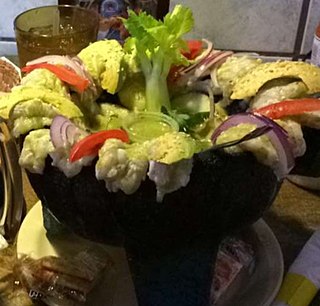 W
WAguachile is a Mexican dish made of shrimp, submerged in liquid seasoned with chili peppers, lime juice, salt, cilantro, slices of cucumber and slices of onion. Raw vegetables such as cucumber are usually added. This raw seafood dish comes from the west region of Mexico and is normally prepared in a molcajete. The origin of aguachile lies in the coast of Sinaloa, originally made with boiled water and chiltepines, small round chili peppers from Sinaloa.
 W
WCanned or tinned fish are fish which have been processed, sealed in an airtight container such as a sealed tin can, and subjected to heat. Canning is a method of preserving food, and provides a typical shelf life ranging from one to five years.
 W
WThe Caridea, commonly known as caridean shrimp or true shrimp, are an infraorder of shrimp within the order Decapoda. This infraorder contain all species of true shrimp. They are found widely around the world in both fresh and salt water. Many other animals with similar names – such as ghost shrimps, mud shrimps, and boxer shrimps – are not true shrimps, but many have evolved features similar to true shrimps.
 W
WCarpaccio is a dish of meat or fish, thinly sliced or pounded thin, and served raw, typically as an appetizer. It was invented in 1950 by Giuseppe Cipriani from Harry's Bar in Venice and popularised during the second half of the twentieth century. The beef was served with lemon, olive oil, and white truffle or Parmesan cheese. Later, the term was extended to dishes containing other raw meats or fish, thinly sliced and served with lemon or vinegar, olive oil, salt and ground pepper.
 W
WClupeinae is a subfamily of herrings, sardines and sprats belonging to the family Clupeidae.
 W
WConpoy or dried scallop is a type of Cantonese dried seafood product made from the adductor muscle of scallops. The smell of conpoy is marine, pungent, and reminiscent of certain salt-cured meats. Its taste is rich in umami due to its high content of various free amino acids, such as glycine, alanine, and glutamic acid. It is also rich in nucleic acids such as inosinic acid, amino acid byproducts such as taurine, and minerals, such as calcium and zinc.
 W
WConsider the Oyster is a book by M. F. K. Fisher that deals in the history, preparation and eating of oysters. The work was first published in the United States in 1941 and has been in print ever since.
 W
WCrab boil is a spice mixture that is used to flavor the water in which crabs or other shellfish are boiled. A crab boil is also a social event where boiled crabs are eaten, a kind of seafood boil. Crab boils are known in the Ville Platte areas of Louisiana as "dome lobster boils," stemming from the local term "dome lobster" based on the shape and composition of crabs and their likeness to a domed lobster. The largest of these gatherings is the Crayon d'Orange festival in Evangeline Parish.
 W
WCrab meat or crabmeat is the meat found within a crab. It is used in many cuisines across the world, prized for its soft, delicate and sweet taste. Crab meat is low in fat and contains around 340 kJ (82 kcal) per 85-gram (3 oz) serving. Brown crab, blue crabs, blue swimming crabs, and red swimming crabs are among the most commercially available species of crabmeat globally.
 W
WDendrobranchiata is a suborder of decapods, commonly known as prawns. There are 540 extant species in seven families, and a fossil record extending back to the Devonian. They differ from related animals, such as Caridea and Stenopodidea, by the branching form of the gills and by the fact that they do not brood their eggs, but release them directly into the water. They may reach a length of over 330 millimetres (13 in) and a mass of 450 grams (1.0 lb), and are widely fished and farmed for human consumption.
 W
WDepuration of seafood is the process by which marine or freshwater animals are placed into a clean water environment for a period of time to allow purging of biological contaminants and physical impurities. The most common subjects of depuration are such bivalves as oysters, clams, and mussels.
 W
WEels are elongated fish, ranging in length from 5 centimetres (2.0 in) to 4 metres (13 ft). Adults range in weight from 30 grams to over 25 kilograms. They possess no pelvic fins, and many species also lack pectoral fins. The dorsal and anal fins are fused with the caudal or tail fin, forming a single ribbon running along much of the length of the animal. Most eels live in the shallow waters of the ocean and burrow into sand, mud, or amongst rocks. A majority of eel species are nocturnal and thus are rarely seen. Sometimes, they are seen living together in holes, or "eel pits". Some species of eels live in deeper water on the continental shelves and over the slopes deep as 4,000 metres (13,000 ft). Only members of the family Anguillidae regularly inhabit fresh water, but they too return to the sea to breed.
 W
WFish are aquatic, craniate, gill-bearing animals that lack limbs with digits. They form a sister group to the tunicates, together forming the olfactores. Included in this definition are the living hagfish, lampreys, and cartilaginous and bony fish as well as various extinct related groups. Around 99% of living fish species are ray-finned fish, belonging to the class Actinopterygii, with over 95% belonging to the teleost subgrouping.
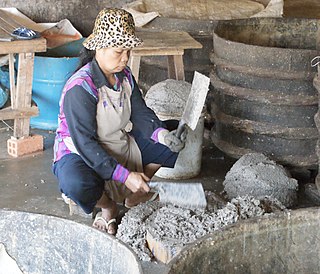 W
WFish paste is fish which has been chemically broken down by a fermentation process until it reaches the consistency of a soft creamy purée or paste. Alternatively it refers to cooked fish which has been physically broken down by pounding, grinding, pressing, mincing, blending, and/or sieving, until it reaches the consistency of paste. The term can be applied also to shellfish pastes, such as shrimp paste or crab paste.
 W
WA fish fry is a meal containing battered or breaded fried fish. It usually also includes french fries, coleslaw, hushpuppies, lemon slices, tartar sauce, hot sauce, malt vinegar and dessert. Some Native American versions are cooked by coating fish with semolina and egg yolk.
 W
WHerring are forage fish, mostly belonging to the family Clupeidae.
 W
WHerring are forage fish in the wild, mostly belonging to the family Clupeidae, but they are also an important food for humans. Herring often move in large schools around fishing banks and near the coast. The most abundant and commercially important species belong to the genus Clupea, found particularly in shallow, temperate waters of the North Pacific and North Atlantic Oceans, including the Baltic Sea, as well as off the west coast of South America. Three species of Clupea are recognized; the main taxon, the Atlantic herring, accounts for over half the world's commercial capture of herrings.
 W
WThe harvesting and consuming of seafoods are ancient practices that may date back to at least the Upper Paleolithic period which dates to between 50,000 and 10,000 years ago. Isotopic analysis of the skeletal remains of Tianyuan man, a 40,000-year-old modern human from eastern Asia, has shown that he regularly consumed freshwater fish. Archaeology features such as shell middens, discarded fish bones and cave paintings show that sea foods were important for survival and consumed in significant quantities. During this period, most people lived a hunter-gatherer lifestyle and were, of necessity, constantly on the move. However, where there are early examples of permanent settlements such as those at Lepenski Vir, they are almost always associated with fishing as a major source of food.
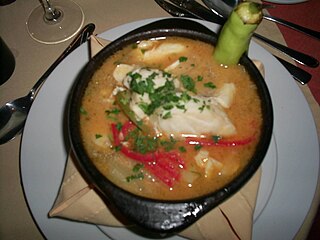 W
WThis is a list of soups made with fish or seafood.
 W
WLobsters are a family of large marine crustaceans.
 W
WLouisiana Department of Culture, Recreation & Tourism is a state agency and department within the Office of the Lt. Governor. The department is composed of six offices, Office of the Secretary, Office of State Library, Office of State Museum, Office of State Parks, Office of Cultural Development, and Office of Tourism.
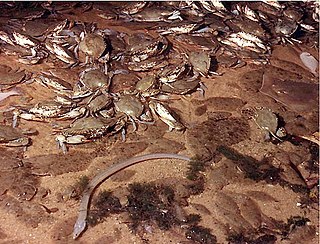 W
WJubilee is the name used locally for a natural phenomenon that occurs sporadically on the shores of Mobile Bay, a large body of water on Alabama's Gulf Coast. During a jubilee many species of crab and shrimp, as well as flounder, eels, and other demersal fish will leave deeper waters and swarm—in large numbers and very high density—in a specific, shallower coastal area of the bay. A jubilee is a celebrated event in Mobile Bay, and it attracts large crowds, many drawn by the promise of abundant and easy-to-catch seafood.
 W
WNeurotoxic shellfish poisoning (NSP) is a term used to describe the disease caused by consumption of brevetoxins, which are marine toxins produced by the dinoflagellate Karenia brevis. These toxins can produce a series of gastrointestinal and neurological effects. Outbreaks of NSP commonly take place following harmful algal bloom (HAB) events, commonly referred to as “Florida red tide”. Algal blooms are a naturally-occurring phenomenon, however their frequency has been increasing in recent decades at least in-part due to human activities, climate changes, and the eutrophication of marine waters. HABs have been occurring for all of documented history, evidenced by the Native Americans' understanding of the dangers of shellfish consumption during periods of marine bioluminescence. Blooms have been noted to occur as far north as North Carolina and are commonly seen alongside the widespread death of fish and sea birds. In addition to the effects on human health, the economic impact of HAB-associated shellfish toxin outbreaks can have significant economic implications as well due to not only the associated healthcare costs, but the adverse impact on the commercial shellfish industry.
 W
WAn oyster bar, also known as an oyster saloon, oyster house or a raw bar service, is a restaurant specializing in serving oysters, or a section of a restaurant which serves oysters buffet-style. In France, the oyster bar is known as bar à huîtres. Oysters have been consumed since ancient times and were common tavern food in Europe, but the oyster bar as a distinct restaurant began making an appearance in the 18th century.
 W
WParalytic shellfish poisoning (PSP) is one of the four recognized syndromes of shellfish poisoning, which share some common features and are primarily associated with bivalve mollusks. These shellfish are filter feeders and accumulate neurotoxins, chiefly saxitoxin, produced by microscopic algae, such as dinoflagellates, diatoms, and cyanobacteria. Dinoflagellates of the genus Alexandrium are the most numerous and widespread saxitoxin producers and are responsible for PSP blooms in subarctic, temperate, and tropical locations. The majority of toxic blooms have been caused by the morphospecies Alexandrium catenella, Alexandrium tamarense, Gonyaulax catenella and Alexandrium fundyense, which together comprise the A. tamarense species complex. In Asia, PSP is mostly associated with the occurrence of the species Pyrodinium bahamense.
 W
WPellonulinae is a subfamily of freshwater herrings belonging to the family Clupeidae.
 W
WPescetarianism is the practice of using seafood as the only source of meat in a diet that is otherwise vegetarian.
 W
WA raw bar is a small restaurant or a bar within a restaurant where live raw shellfish are shucked and served. Raw bars typically offer a variety of raw and cooked seafood and shellfish that is served cold. Seafood-based dishes may also be offered, and additional, non-seafood foods may also be part of the fare. Raw bars may offer alcoholic beverages such as oyster shooters, as well as wine and sake that is paired with various foods. Additional accompaniments may include condiments, sauces and foods such as lemon and lime. Several restaurants in the United States offer raw bars, some of which are seasonal.
 W
WA seafood basket, also known as the fisherman's basket, is a fried dish usually consisting of fried seafood including fish fillet, prawns and calamari. Additional foods used can include fried scallops, oysters and crab sticks. It typically includes one or more dipping sauces, such as cocktail sauce, and may include chips. It is a similar dish to fish and chips.
 W
WSeafood boil is the generic term for any number of types of social events in which shellfish, whether saltwater or freshwater, is the central element. Regional variations dictate the kinds of seafood, the accompaniments and side dishes, and the preparation techniques. In some cases, a boil may be sponsored by a community organization as a fund-raiser or a mixer. In this way, seafood boils are like a fish fry, barbecue, or church potluck supper. Boils are also held by individuals for their friends and family for a weekend get-together and on the holidays of Memorial Day and Independence Day. While boils and bakes are traditionally associated with coastal regions of the United States, there are exceptions.
 W
WShark meat is a seafood consisting of the flesh of sharks. Its consumption by humans has been mentioned since the fourth century AD in literature. Several sharks are fished for human consumption, such as porbeagles, shortfin mako shark, requiem shark, and thresher shark, among others. Shark meat is popular in Asia, where it is often consumed dried, smoked, or salted. Shark meat is consumed regularly in Scandinavia, Japan, Australia, parts of India, parts of Canada, Sri Lanka, areas of Africa and Mexico. In western cultures, shark meat is sometimes considered as a taboo, although its popularity has increased in Western countries.
 W
WShellfish is a colloquial and fisheries term for exoskeleton-bearing aquatic invertebrates used as food, including various species of molluscs, crustaceans, and echinoderms. Although most kinds of shellfish are harvested from saltwater environments, some are found in freshwater. In addition, a few species of land crabs are eaten, for example Cardisoma guanhumi in the Caribbean. Shellfish are among the most common food allergens.
 W
WShrimp are decapod crustaceans with elongated bodies and a primarily swimming mode of locomotion – most commonly Caridea and Dendrobranchiata. More narrow definitions may be restricted to Caridea, to smaller species of either group or to only the marine species. Under a broader definition, shrimp may be synonymous with prawn, covering stalk-eyed swimming crustaceans with long narrow muscular tails (abdomens), long whiskers (antennae), and slender legs. Any small crustacean which resembles a shrimp tends to be called one. They swim forward by paddling with swimmerets on the underside of their abdomens, although their escape response is typically repeated flicks with the tail driving them backwards very quickly. Crabs and lobsters have strong walking legs, whereas shrimp have thin, fragile legs which they use primarily for perching.
 W
WShrimp and prawn are types of seafood that are consumed worldwide. Although shrimp and prawns belong to different suborders of Decapoda, they are very similar in appearance and the terms are often used interchangeably in commercial farming and wild fisheries. A distinction is drawn in recent aquaculture literature, which increasingly uses the term "prawn" only for the freshwater forms of palaemonids and "shrimp" for the marine penaeids.
 W
W"Shrimp on the barbie" is a phrase that originated in a series of television advertisements by the Australian Tourism Commission starring Paul Hogan from 1984 through to 1990. The full quote spoken by Hogan is "I'll slip an extra shrimp on the barbie for you", and the actual slogan of the ad was "Come and say G'day". It has since been used, along with some variations, to make reference to Australia in popular culture.
 W
WThe snakelocks anemone is a sea anemone found in the eastern Atlantic Ocean and the Mediterranean Sea. The latter population is however sometimes considered a separate species, the Mediterranean snakelocks anemone.
 W
WSquid is eaten in many cuisines; in English, the culinary name calamari is often used for squid dishes. There are many ways to prepare and cook squid. Fried squid is common in the Mediterranean. In Lebanon and Syria, however, it is served with tartar sauce. In New Zealand, Australia, the United States, and South Africa, it is sold in fish and chip shops. In Britain, it can be found in Mediterranean 'calamari' or Asian 'salt and pepper fried squid' forms in various establishments, often served as a bar snack, street food, or starter.
 W
WTomalley, crab fat, or lobster paste is the soft, green substance found in the body cavity of lobsters, that fulfills the functions of both the liver and the pancreas. Tomalley corresponds to the hepatopancreas in other arthropods. It is considered a delicacy, and may be eaten alone but is often added to sauces for flavour and as a thickening agent. The term lobster paste or lobster pâté can also be used to indicate a mixture of tomalley and lobster roe. Lobster bisque, lobster stock, and lobster consommé are made using lobster bodies (heads), often including the lobster liver.
 W
WTrepanging is the act of collection or harvesting of sea cucumbers, known in Indonesian as trepang, Malay těripang, and used as food. The collector, or fisher, of trepang is a trepanger.
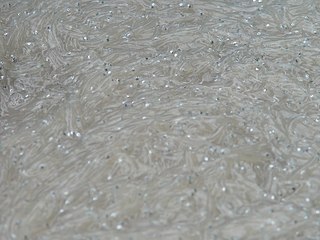 W
WWhitebait is a collective term for the immature fry of fish, typically between 1 and 2 inches long. Such young fish often travel together in schools along the coast, and move into estuaries and sometimes up rivers where they can be easily caught with fine meshed fishing nets. Whitebaiting is the activity of catching whitebait.
 W
WYlistrum balloti, known as Ballot's saucer scallop is found around the waters of Australia. This scallop may live for a maximum of four years, and reach 14 cm in shell length, though more commonly 8 to 9 cm. Well regarded as seafood in Asia and Australia.
 W
WYlistrum japonicum, known as saucer scallop is found around the waters of Japan, Philippines, south eastern Asia and Australia. Well regarded as seafood in Asia and Australia.